The Flashforge Adventurer 5M Pro operates at 600 mm/s with a build volume of 220 x 220 x 220 mm, leveraging a CoreXY structure for stability during high-speed printing. The Bambu Lab P1S provides a larger 256 x 256 x 256 mm build area, reaching speeds of 500 mm/s. Both printers use enclosed frames with built-in cameras, though their capabilities and target applications differ significantly.
Print testing covered material compatibility, speed verification, and precision measurements. The Adventurer 5M Pro integrates a quick-swap nozzle system and dual filtration for VOCs and particles. The P1S implements an AMS multi-color printing system and advanced auto-bed leveling with vibration compensation.
Through rigorous testing of both printers’ capabilities across multiple print scenarios, this comparison provides a detailed assessment of their strengths and limitations. The evaluation covers essential factors including print quality, speed, ease of use, and overall value proposition for different user segments.
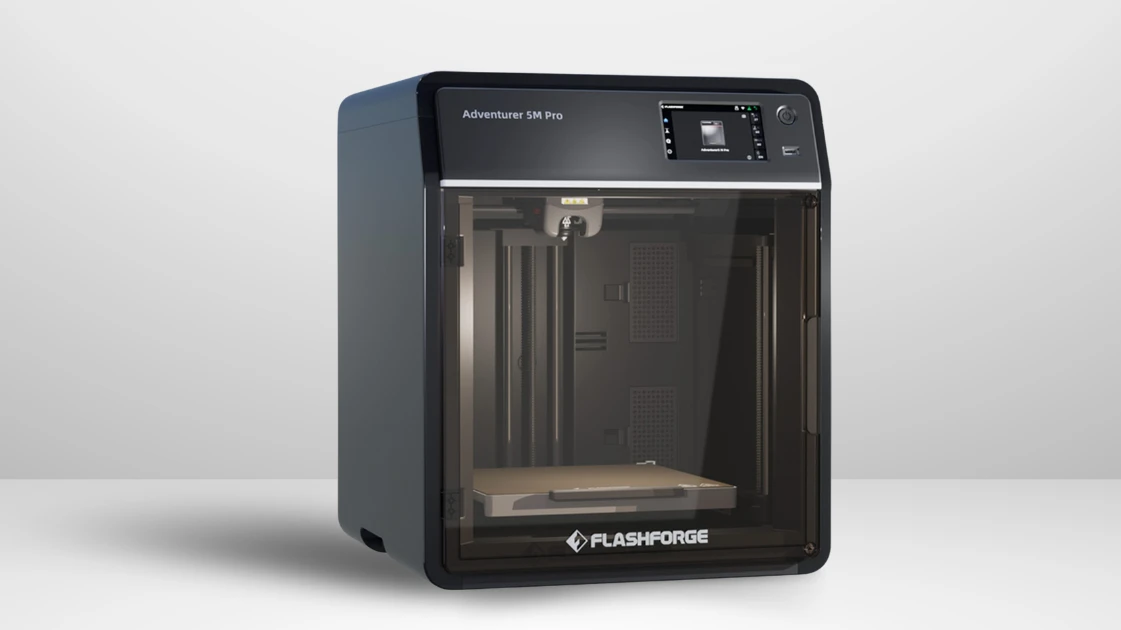
Adventurer 5M Pro
Released: 2023 September
Key Features: 220 × 220 × 220 mm³ | All-Metal CoreXY frame | Max nozzle temperature 280°C | Direct drive extruder | Auto-leveling | Dual air filtration (HEPA & carbon) | PLA, PETG, TPU, ABS, ASA, PLA-CF, PETG-CF support | Wi-Fi, USB, Ethernet
Price Range:At $499
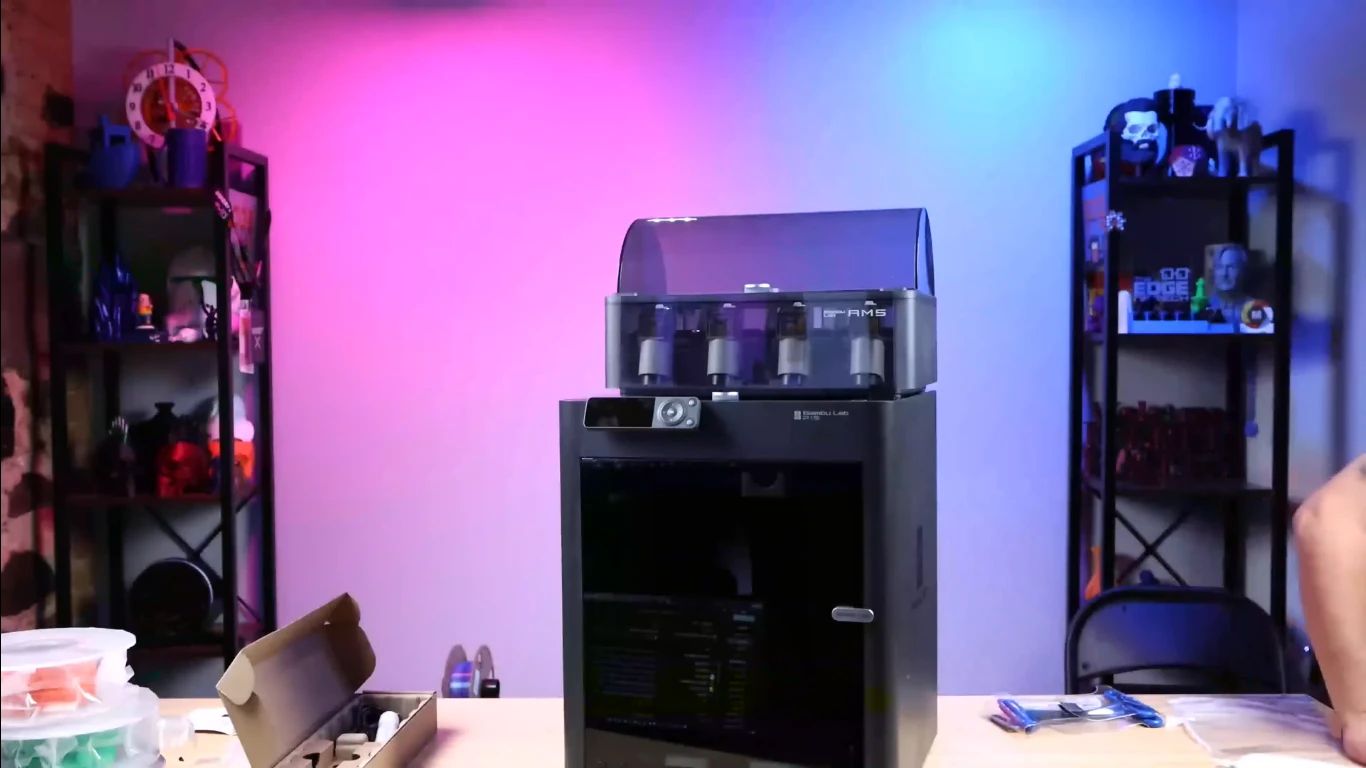
Bambu Lab P1S
Released: 2023 August
Key Features:256 × 256 × 256 mm³ | Steel chassis with plastic & glass enclosure | Max nozzle temperature 300°C | Direct drive extruder | Auto-leveling | Activated carbon filter | PLA, PETG, TPU, ABS, ASA, PA, PC, PVA support | Wi-Fi, Bluetooth, Micro SD
Price Range:Starts at $599
Setup Experience: A Smooth Start
Setting up a 3D printer can be daunting, but both machines prioritize ease of use. The Adventurer 5M Pro arrives 95% pre-assembled. Installing the filament holder and touchscreen takes about 10 minutes. The manual is straightforward, and the auto-leveling feature simplifies calibration. Meanwhile, the Bambu P1S offers a similarly effortless experience. It comes almost fully assembled, requiring minimal effort beyond connecting the display and removing transport locks. The auto-calibration system is thorough, including bed leveling and vibration compensation. Both machines deliver a stress-free start, but the P1S’s advanced calibration gives it a slight edge for beginners seeking precision out of the box.
Flashforge Adventurer 5M Pro vs Bambu Lab P1S Specification Chart
| Feature | Flashforge Adventurer 5M Pro | Bambu Lab P1S |
|---|---|---|
| Build Volume | 220 x 220 x 220 mm | 256 x 256 x 256 mm |
| Max Speed | 600 mm/s | 500 mm/s |
| Max Acceleration | 20,000 mm/s² | 20,000 mm/s² |
| Display | 4.3-inch color touchscreen | 2.7-inch display |
| Filament Compatibility | PLA, PETG, ABS, TPU, Carbon Fiber | PLA, PETG, ABS, TPU, ASA, PC |
| Nozzle Temperature | 280°C | 300°C |
| Special Features | Quick-Swap Nozzle, Dual Filtration | AMS Multi-Color Printing, Auto-Bed Leveling |
| Camera | Built-In for Monitoring & Timelapse | Built-In for Monitoring & Timelapse |
| Software | FlashPrint 5, Orca Compatible | Bambu Studio, Handy App |
| Connectivity | Wi-Fi, Ethernet, USB | Wi-Fi, Bluetooth, Bambu-Bus |
| Noise Levels | 50-70 dB (depending on enclosure) | 62-64 dB (quieter when fully enclosed) |
| Price | $499 | $599 ($799 with AMS Combo) |
Build and Design: Compact vs Robust
The Adventurer 5M Pro features a CoreXY structure, known for its stability during high-speed printing. Its enclosed design ensures safety and consistent temperature control, ideal for materials like ABS. The frame is a mix of metal and durable plastic, with dual air filtration to capture VOCs and ultrafine particles. It’s compact, making it suitable for desktops.
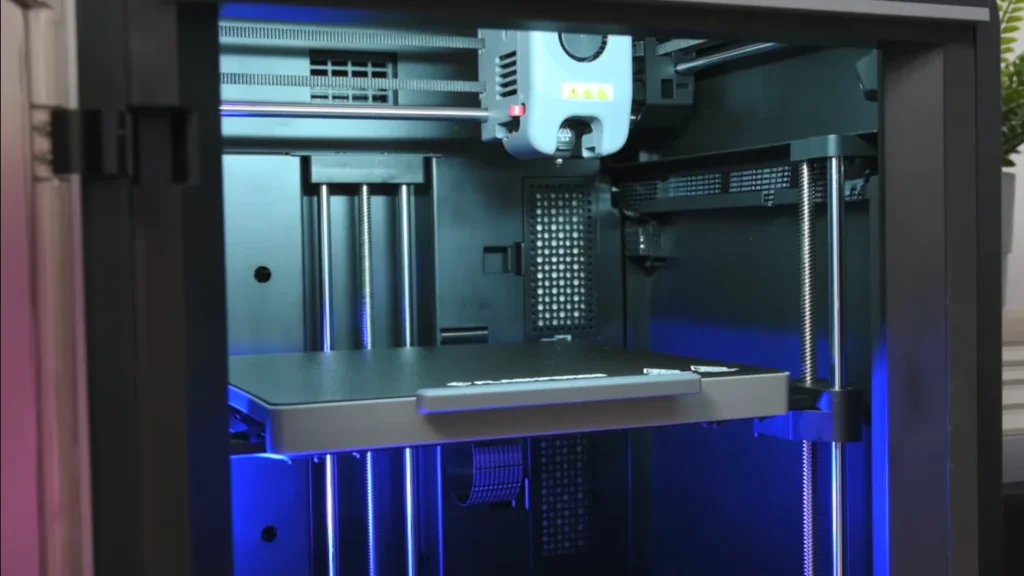
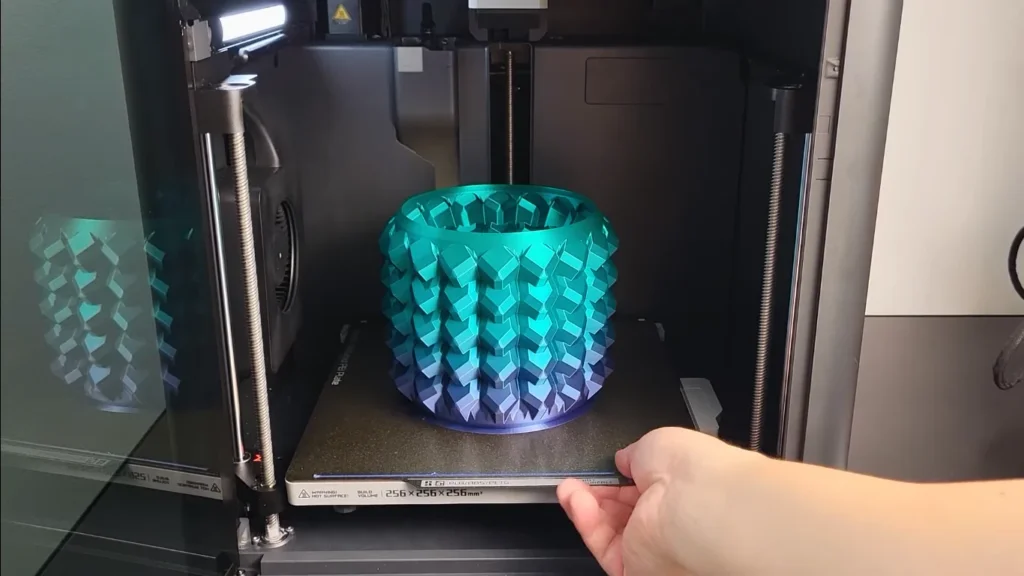
In contrast, the P1S adopts a slightly larger footprint but remains sleek. Its enclosure integrates tempered glass panels, offering a premium look and feel. The sturdy steel chassis ensures minimal vibration, even at top speeds. Both printers are thoughtfully designed, but the P1S’s tempered glass and polished aesthetic feel more premium.
Winner: Bambu Lab P1S
In contrast, the P1S adopts a slightly larger footprint but remains sleek. Its enclosure integrates tempered glass panels, offering a premium look and feel. The sturdy steel chassis ensures minimal vibration, even at top speeds. Both printers are thoughtfully designed, but the P1S’s tempered glass and polished aesthetic feel more premium.
Printing Speed and Precision
Speed is where these printers shine. The Adventurer 5M Pro boasts a maximum speed of 600 mm/s with an acceleration of 20,000 mm/s². Its vibration suppression algorithm minimizes ghosting and ringing, producing smooth, detailed prints even at high speeds. The quick-swap nozzle system—including a default 0.4 mm and optional sizes—adds versatility, making it easy to balance speed and detail.
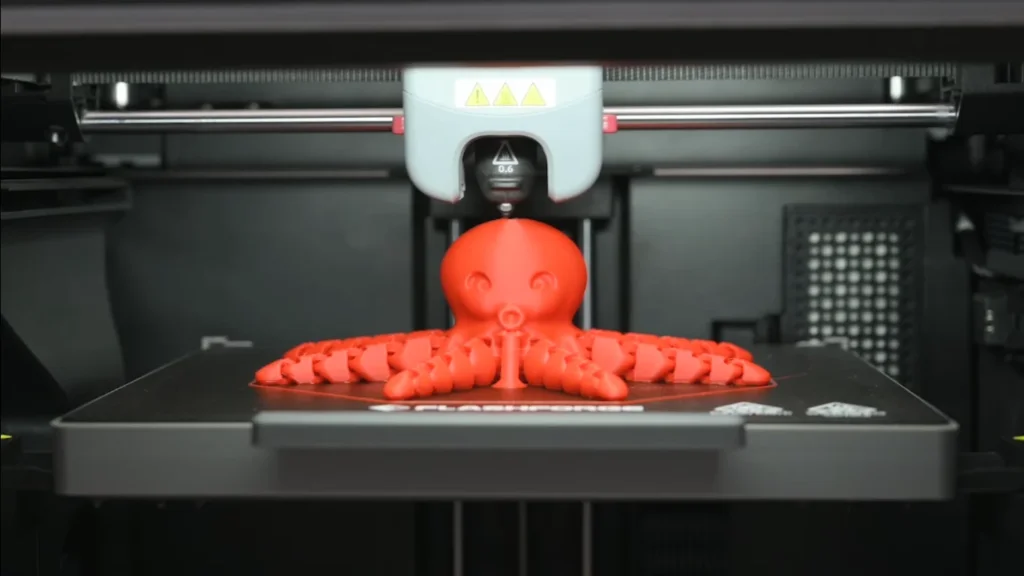

The Bambu P1S isn’t far behind, achieving speeds up to 500 mm/s with the same acceleration. Its advanced motion algorithms ensure precise layer placement, and features like pressure advance further enhance quality. Printing a standard Benchy in under 18 minutes is no small feat, and the results are impressively clean. While the Adventurer 5M Pro prioritizes efficiency, the P1S leans into finesse, offering excellent performance for complex models.
Winner: Flashforge Adventurer 5M Pro (for speed) / Bambu Lab P1S (for finesse)
The Bambu P1S isn’t far behind, achieving speeds up to 500 mm/s with the same acceleration. Its advanced motion algorithms ensure precise layer placement, and features like pressure advance further enhance quality. Printing a standard Benchy in under 18 minutes is no small feat, and the results are impressively clean. While the Adventurer 5M Pro prioritizes efficiency, the P1S leans into finesse, offering excellent performance for complex models.
Filament Compatibility: Versatility Matters
Filament options can make or break a printer. The Adventurer 5M Pro handles a wide range, including PLA, PETG, ABS, TPU, and carbon fiber-infused variants. Its nozzle reaches 280°C, accommodating materials requiring higher temperatures. The dual filtration system keeps the workspace safe from fumes, a vital feature for home users.
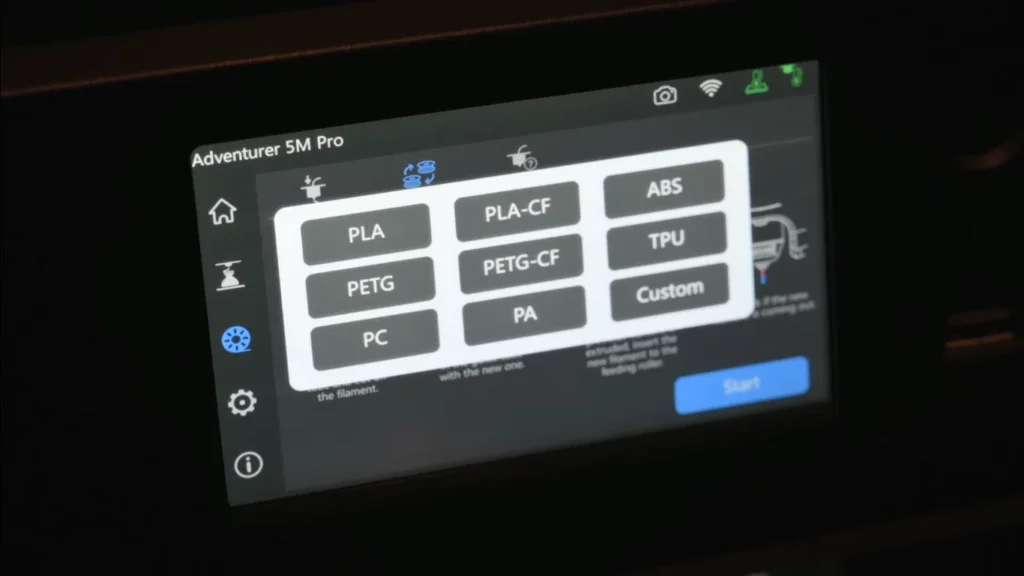

The P1S supports a similarly broad spectrum of filaments. Its nozzle temperature peaks at 300°C, slightly higher than the Adventurer’s. The optional AMS unit unlocks multi-color printing with up to 16 colors, adding a layer of creativity for advanced users. While both machines offer versatility, the P1S’s AMS system sets it apart for users interested in multi-material projects.
Winner: Bambu Lab P1S
The P1S supports a similarly broad spectrum of filaments. Its nozzle temperature peaks at 300°C, slightly higher than the Adventurer’s. The optional AMS unit unlocks multi-color printing with up to 16 colors, adding a layer of creativity for advanced users. While both machines offer versatility, the P1S’s AMS system sets it apart for users interested in multi-material projects.
Usability and Software
Navigating a printer’s software can define the overall experience. The Adventurer 5M Pro uses FlashPrint 5, which is functional but basic. Orca Slicer compatibility offers more advanced features, but the lack of presets for various layer heights can be limiting. Remote control through the app is handy, and the 4.3-inch touchscreen is responsive, though not perfect.
The P1S integrates seamlessly with Bambu Studio and the Bambu Handy app. These tools simplify slicing, monitoring, and file transfers. Notifications for print progress and remote control options enhance convenience. The built-in camera supports time-lapse creation and live monitoring, though the 720p resolution leaves room for improvement. Overall, the P1S’s polished software ecosystem makes it a more user-friendly choice.
Print Quality: Results That Impress
Both printers deliver excellent print quality, but nuances exist. The Adventurer 5M Pro’s textured PEI bed ensures strong adhesion, reducing warping on large prints. Layer lines are consistent, and its ability to handle detailed models like figurines or prototypes is commendable. The quick-swap nozzle system allows easy optimization for different projects.
The P1S matches, if not exceeds, this performance. Intricate designs and functional parts print flawlessly, with sharp details and smooth surfaces. The auto-calibration ensures consistent results across multiple prints. While both printers excel in quality, the P1S’s precision and reliability slightly edge out the Adventurer.
Advance Future
Flashforge Adventurer 5M Pro
Quick-Swap Nozzle System
The Adventurer 5M Pro’s quick-swap nozzle system makes changing nozzles effortless. This versatility allows users to adapt to different project needs with ease.
Dual Air Filtration
Equipped with HEPA and activated carbon filters, the 5M Pro ensures safe printing by capturing VOCs and ultrafine particles. This feature makes it a suitable choice for home and educational environments.
Vibration Suppression Algorithm
High-speed prints benefit from the vibration suppression algorithm, which minimizes ghosting and ringing. The result is smoother, more precise models.
Automatic Z-Offset and Leveling
Setting up the Adventurer 5M Pro is straightforward, thanks to its automatic Z-offset and leveling system. It simplifies calibration and ensures accurate layer placement.
CoreXY Architecture
The CoreXY design enhances stability and precision during high-speed operations. It’s a testament to the printer’s focus on reliability.
Magnetic, Dual-Sided PEI Build Plate
The magnetic, dual-sided PEI build plate offers excellent adhesion and effortless model removal. Its textured surface ensures consistent results across various filaments.
Built-In Camera
The built-in camera supports real-time monitoring and time-lapse creation, adding a layer of convenience for users who want to keep an eye on their prints remotely.
Bambu Lab P1S
Auto-Bed Leveling and Vibration Compensation
The Bambu Lab P1S streamlines calibration with its auto-bed leveling and vibration compensation features. This ensures a seamless setup process, delivering consistently accurate prints right out of the box.
Pressure Advance Control
High-speed printing often sacrifices quality, but the P1S incorporates pressure advance control. This technology ensures that even at rapid speeds, layer transitions remain sharp and clean.
Multi-Color Printing
With the optional AMS unit, the P1S supports multi-color printing, handling up to 16 colors. This capability unlocks creative possibilities for intricate designs and professional projects.
Built-In Camera
The built-in camera is a standout feature for remote monitoring and creating time-lapse recordings. While the resolution could improve, its utility in tracking print progress is invaluable.
All-Metal Hotend
Durability and versatility are key with the P1S’s all-metal hotend. It handles high-temperature filaments effortlessly, expanding the range of printable materials.
Direct-Drive Extruder
Precision is paramount, and the direct-drive extruder delivers just that. It provides accurate filament extrusion, crucial for detailed prints.
Semi-Automatic Belt Tensioning
The semi-automatic belt tensioning mechanism ensures consistent performance, reducing maintenance demands over time.
Enclosure with Fan and Carbon Filter
The fully enclosed design, combined with a fan and carbon filter, supports advanced materials while maintaining safety and air quality.
Noise Levels: Keeping It Quiet
The Flashforge Adventurer 5M Pro produces sound levels in the high 60s to low 70s decibels (dB) when running at its top speed, measured six inches away. The primary source of noise is the large auxiliary fan, a common feature in newer printers. However, when the machine is fully enclosed, the noise drops to the mid-to-high 50s dB range, making it suitable for quieter environments.
The Bambu Lab P1S, on the other hand, varies depending on its configuration. With the top glass panel off and the door open, noise levels hover around 62-64 dB. Adding the top glass panel slightly directs sound toward the noise meter but does not significantly increase peak levels. When fully enclosed with the door closed, the noise is muffled further, resulting in a slight overall drop in decibel levels. This makes the P1S quieter than the Adventurer 5M Pro in most scenarios.
Winner: Bambu Lab P1S
The Bambu Lab P1S, on the other hand, varies depending on its configuration. With the top glass panel off and the door open, noise levels hover around 62-64 dB. Adding the top glass panel slightly directs sound toward the noise meter but does not significantly increase peak levels. When fully enclosed with the door closed, the noise is muffled further, resulting in a slight overall drop in decibel levels. This makes the P1S quieter than the Adventurer 5M Pro in most scenarios.
Value and Pricing
The Adventurer 5M Pro is priced at $499, making it an affordable option for high-speed, enclosed printing. Its features are robust for the price, catering to hobbyists and small businesses. Add-ons like spare nozzles and premium filaments are reasonably priced, enhancing its value.
The Bambu P1S starts at $599, with an AMS combo option at $799. While pricier, it justifies the cost with advanced features, better software, and a polished build. For users seeking premium performance and ease of use, the P1S is worth the investment.
Which to Choose?
Choose the Flashforge Adventurer 5M Pro If:
- You’re a beginner looking for an affordable entry into 3D printing.
- Noise levels are not a top concern.
- Your primary focus is on single-material projects and ease of use.
- A compact printer with a straightforward setup process suits your needs.
Choose the Bambu Lab P1S If:
- You want advanced features like multi-color printing and higher filament compatibility.
- Precision and detailed designs are crucial for your projects.
- Quieter operation and a premium build quality are important.
- Budget is flexible, and you’re seeking a printer with a polished software ecosystem.
Final Thoughts
The comparative analysis of the Flashforge Adventurer 5M Pro and Bambu Lab P1S reveals distinct advantages for different user requirements. The Adventurer 5M Pro demonstrates exceptional value at its $499 price point, delivering high-speed printing capabilities and reliable performance in an enclosed system. Its straightforward operation and consistent results make it particularly suitable for users prioritizing efficiency and ease of use.
The Bambu Lab P1S starts at $599, with an AMS combo option at $799. While pricier, it justifies the cost with advanced features, better software, and a polished build. For users seeking premium performance and ease of use, the P1S is worth the investment.
Both printers represent significant advancements in consumer 3D printing technology, offering reliable performance and valuable features at their respective price points. The Adventurer 5M Pro excels in providing essential functionality at an accessible price, while the P1S delivers a more comprehensive feature set for users requiring advanced capabilities.
The Flashforge Adventurer 5M Pro is more beginner-friendly due to its lower cost, ease of setup, and straightforward software. Its pre-assembled design and automatic leveling make it an excellent choice for those new to 3D printing.
Yes, the Bambu Lab P1S supports multi-color printing with its optional AMS (Automatic Material System) unit, capable of handling up to 16 colors. This feature is ideal for advanced projects requiring vibrant, multi-colored designs.
The Bambu Lab P1S is quieter than the Flashforge Adventurer 5M Pro, thanks to its optimized fan control and better enclosure design. If a quiet operation is essential, the P1S is the better choice.
Both printers support a wide range of materials. The Adventurer 5M Pro works with PLA, PETG, ABS, TPU, and carbon fiber-infused filaments, while the Bambu Lab P1S supports similar materials and adds ASA and PC, thanks to its higher nozzle temperature of 300°C.
Nikko Jenkins is a technology journalist based in the US, covering tool reviews and comparisons across North America, Europe and Asia, particularly 3D Printers. His concise, insightful articles on the latest innovations help readers worldwide make informed tech decisions. Jenkins’ expertise and engaging style have made him a respected voice in the global technology landscape.
Feel free to reach out to me at nikkojenkins@360techinsights.com.




